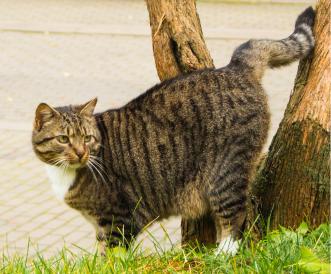When is a Wee a Spray?
Knowing the difference between these two functions can assist you in understanding your cat’s welfare needs as the two are very different.
Urination is the routine function of emptying the bladder and this is normally performed in a squatting position after digging in a soft substrate and then neatly covered up afterwards in an attempt to hide their scent from predators.
Spraying is a deposition of urine usually found on vertical surfaces outside of the litter box, cats use this as a means of communication. These are usually small to medium amounts of deposits that are sprayed in comparison to urination and contain an extra odour specifically for territorial marking called Felinine.
All cats have scent glands on their cheeks, chin, lips, interdigital within the pads of their feet and on the base of the tail, and near the anus. These scent glands are also used for the important task of marking out territory as well as being used as a form of communication – a way for cats to give information about themselves and to gather it from other felines in their environment either indoor or outdoor.
When a cat sprays the cat will stand, back up against a wall, door, or piece of furniture, and spray urine on a vertical surface. The cat backs up towards a surface and stands on tiptoes on the back legs, tail held vertically and quivering, with the hind feet treading alternately. In this position a jetted stream of urine is directed backwards, usually onto a vertical surface This is a natural part of their behaviour patterns and both genders spray, contrary to some beliefs that it is only male cats that will rehearse this behaviour.

After a normal squat urination cats will attempt to bury or cover the urine, but there is no attempt to cover spray marks and the urine is deposited at the cat ‘nose height’ so that it can be evident to other cats. Cats show a lot more interest in spray marks than in urine eliminated via squatting and investigation of a spray mark can often elicit a ‘flehmen’ response, which is the funny open-mouthed face that cats pull when they smell something exciting.
Stress and anxiety may bring on insecurity, fear, and timidity, and cause cats to spray which they do to feel more secure and content as well as take control over their boundary within their environment
Possible reasons for spraying include-
Re-directed-Territorial behaviour is seen when cats meet within the same environment and one is new to that environment. This is commonly seen within multi-cat households and urban areas when cats must share territories on a much smaller scale, the aggression is not directed directly to the offensive cat that is trespassing on the territory but is displayed as a result of seeing the cat within territorial boundaries. This can then be displayed within the home as destruction or spraying.
Anxiety- a change of personality, hiding, anorexia, indoor elimination outside of the box, change of defecation habits, reluctance to play, depression, over-grooming, OCD, excessive scent-marking spraying clawing, aggression, vocalisation, attention seeking all may be seen singularly or any combination may be seen.
In many cases, the owner is not aware of the trigger for the spraying or change of behaviours but once this is discovered or you witness your cat spraying then an appropriate cleaning protocol should be implemented and try and work out the ‘WHY’ this has happened. In the environment, the use of synthetic pheromones such as Comfort Zone which mimics the facial ‘feel good’ pheromones composition can help the cat feel more relaxed.
For more detailed information please visit
“Spraying | International Cat Care.” 13 Aug. 2018, https://icatcare.org/advice/spraying/.

Amanda Campion
Clinical Feline Behaviourist

